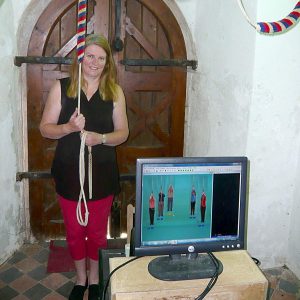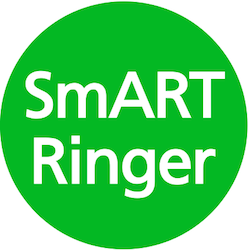It occurred to me the other day, when I was walking like a gymnast on a wooden beam, clutching a stool on a string, with a face full of cobwebs, that this wasn’t what I’d expected when I signed up to learn bell ringing. However, this strange balancing act has become a regular occurrence for me …I started learning to ring about three years ago with huge support from both Farway, my home tower, and other local ringers (too many to mention, you know who you are). I progressed through rope handling, ringing Rounds, Called Changes and Plain Hunt, but then I hit a problem.Like many towers, Farway is sometimes short of numbers and it was rare for there to be enough experienced ringers for more advanced methods at our weekly practice. I tried to join other groups, but I’m still gainfully employed during the week and also have a lovely husband who, although hugely supportive of my ringing, does like to spend some time with me. Consequently I found myself struggling to get enough practice to progress further. However, when Northleigh tower, just five minutes from home, installed a simulator, it was suggested to me that this might be a good solution. I chatted to a few other ringers and quickly found that simulators are a bit like Marmite, either loved or hated, so it was with some trepidation that I agreed to find a bell buddy and give it a go.

Simulator Savvy
Initially, several ringers said to me that they wouldn’t use a simulator as they couldn’t possibly use a computer, it was far too complicated and worrying. However, I soon teamed up with Kathryn who was also keen to give it a go. We’ve found that you really don’t need to be intimidated by the technology. We use Beltower which is an extremely comprehensive and complex program that caters for all levels of ringers. However, the very kind and patient team that installed our system helped us to write out a simple step by step, press that, click this, don’t forget to plug it in, list of instructions. They also helped us to label the laptop we use so that we know where to plug in each cable. This got us going and over time we’ve consulted with them about how to do different things as and when we’ve needed them. Yes, a couple of times we’ve got ourselves in a pickle by pressing the wrong button, but we’ve found that ‘switch it all off and start again’ works wonders 99% of the time. We haven’t broken it yet!
For those of you who haven’t yet used a simulator, the system is quite simple. Firstly you plug the cables into your computer, switch on and log into Beltower. Then you climb the tower and put a tie on the bell that’s had a sensor installed (usually the one closest to the door.) Then you ring up your bell and you’re ready to go. On the screen in front of you there is a picture of five bell ringers (assuming you want to ring Doubles). Our picture shows five people we know so it’s like ringing with friends. Your bell buddy presses the ‘go’ button on the keyboard and a voice says the usual “Look to, treble’s going, treble’s gone”. At this point the ringers on the screen start ringing and you join in as the sixth bell.There are loads of benefits to this system. You can choose which bell you want to ring, which method, for how long and how loud. You can have a Doubles practice with just two people. You can start again as many times as you want and practise, practise, practise the one method you want to perfect. All this without upsetting the neighbours as the computer generates the bell notes and there’s no sound outside. In addition, each strike is shown on a clever colour-coded list from red (not in the correct position), through orange (in the right place, but probably clipping), to green (good) and white (excellent striking). We found this all took some getting used to and the first time we rang we were both horrified to see a list of red strikes just when we were ringing in Rounds! However, we persevered and soon had lists of green and white and moved on to the methods we wanted to practise. Reviewing the list of strikes after each method rung is invaluable, as consistent mistakes quickly show up. I discovered that my leading was poor, handstroke consistently early, followed by an even earlier backstroke. Also, working on a touch of Plain Bob Doubles I could see that I often ‘got lost’ when a bob was whilst dodging up. Using the simulator has given me the opportunity to identify and focus on these problem areas in a way that I couldn’t with real life ringers. Also, the simulator was a real comfort to both Kathryn and me when we were due to ring our first quarter peals. We practised until we could consistently ring accurately for 20 minutes, thinking that if we could manage this, we could probably keep going for 45. This gave us the confidence to give the quarter peal ago without worrying excessively about ‘letting down’ the other ringers.
In conclusion, I would say that the simulator is an essential tool for improving anyone’s ringing. In fact, even the occasional ‘expert’ (who shall remain nameless) has been surprised to find they’re not as good as they think and need a bit of practice. Without the simulator, progressing through Learning the Ropes would be practically impossible for me until I have the luxury of more time during retirement – and I love it far too much to wait that long! And if you’re wondering about the balancing act or the stool on a string … . We couldn’t install our sensor on the bell within easy reach of the tower door, so each time we practise I have to climb across the bell frame to put on the bell tie. I lower the stool onto the floor to create an easy step down – it can’t all be as simple as the simulator!
If youenjoyed this article from the October edition of Tower Talk why not sign up for future editions of this free, quarterly e-magazine for new ringers?

